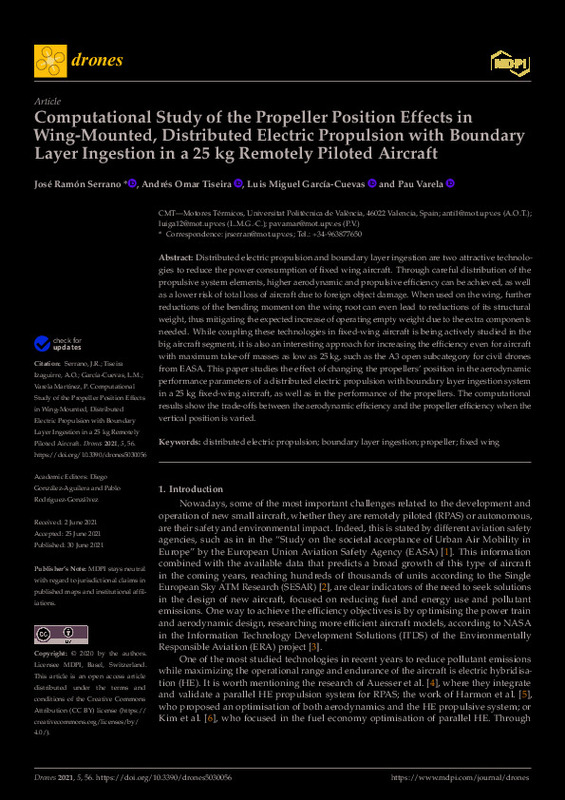JavaScript is disabled for your browser. Some features of this site may not work without it.
Buscar en RiuNet
Listar
Mi cuenta
Estadísticas
Ayuda RiuNet
Admin. UPV
Computational Study of the Propeller Position Effects in Wing-Mounted, Distributed Electric Propulsion with Boundary Layer Ingestion in a 25 kg Remotely Piloted Aircraft
Mostrar el registro sencillo del ítem
Ficheros en el ítem
| dc.contributor.author | Serrano, J.R.
|
es_ES |
| dc.contributor.author | Tiseira, Andrés-Omar
|
es_ES |
| dc.contributor.author | García-Cuevas González, Luis Miguel
|
es_ES |
| dc.contributor.author | Varela-Martínez, Pau
|
es_ES |
| dc.date.accessioned | 2022-10-17T18:03:21Z | |
| dc.date.available | 2022-10-17T18:03:21Z | |
| dc.date.issued | 2021-09 | es_ES |
| dc.identifier.uri | http://hdl.handle.net/10251/188036 | |
| dc.description.abstract | [EN] Distributed electric propulsion and boundary layer ingestion are two attractive technologies to reduce the power consumption of fixed wing aircraft. Through careful distribution of the propulsive system elements, higher aerodynamic and propulsive efficiency can be achieved, as well as a lower risk of total loss of aircraft due to foreign object damage. When used on the wing, further reductions of the bending moment on the wing root can even lead to reductions of its structural weight, thus mitigating the expected increase of operating empty weight due to the extra components needed. While coupling these technologies in fixed-wing aircraft is being actively studied in the big aircraft segment, it is also an interesting approach for increasing the efficiency even for aircraft with maximum take-off masses as low as 25 kg, such as the A3 open subcategory for civil drones from EASA. This paper studies the effect of changing the propellers' position in the aerodynamic performance parameters of a distributed electric propulsion with boundary layer ingestion system in a 25 kg fixed-wing aircraft, as well as in the performance of the propellers. The computational results show the trade-offs between the aerodynamic efficiency and the propeller efficiency when the vertical position is varied. | es_ES |
| dc.description.sponsorship | This research was funded by the Agencia Estatal de Investigacion of Spain through grant number PID2020-119468RA-I00/AEI/10.13039/501100011033. | es_ES |
| dc.language | Inglés | es_ES |
| dc.publisher | MDPI AG | es_ES |
| dc.relation.ispartof | Drones | es_ES |
| dc.rights | Reconocimiento (by) | es_ES |
| dc.subject | Distributed electric propulsion | es_ES |
| dc.subject | Boundary layer ingestion | es_ES |
| dc.subject | Propeller | es_ES |
| dc.subject | Fixed wing | es_ES |
| dc.subject.classification | INGENIERIA AEROESPACIAL | es_ES |
| dc.subject.classification | MAQUINAS Y MOTORES TERMICOS | es_ES |
| dc.title | Computational Study of the Propeller Position Effects in Wing-Mounted, Distributed Electric Propulsion with Boundary Layer Ingestion in a 25 kg Remotely Piloted Aircraft | es_ES |
| dc.type | Artículo | es_ES |
| dc.identifier.doi | 10.3390/drones5030056 | es_ES |
| dc.relation.projectID | info:eu-repo/grantAgreement/AEI/Plan Estatal de Investigación Científica y Técnica y de Innovación 2017-2020/PID2020-119468RA-I00/ES/DISEÑO, CONSTRUCCION Y CONTROL PARA LA GESTION OPTIMA DE MISIONES EN AERONAVES NO TRIPULADAS (UAVS) DE RANGO EXTENDIDO BASADAS EN PILA DE HIDROGENO Y PROPULSION DISTRIBUIDA/ | es_ES |
| dc.rights.accessRights | Abierto | es_ES |
| dc.contributor.affiliation | Universitat Politècnica de València. Departamento de Máquinas y Motores Térmicos - Departament de Màquines i Motors Tèrmics | es_ES |
| dc.description.bibliographicCitation | Serrano, J.; Tiseira, A.; García-Cuevas González, LM.; Varela-Martínez, P. (2021). Computational Study of the Propeller Position Effects in Wing-Mounted, Distributed Electric Propulsion with Boundary Layer Ingestion in a 25 kg Remotely Piloted Aircraft. Drones. 5(3):1-18. https://doi.org/10.3390/drones5030056 | es_ES |
| dc.description.accrualMethod | S | es_ES |
| dc.relation.publisherversion | https://doi.org/10.3390/drones5030056 | es_ES |
| dc.description.upvformatpinicio | 1 | es_ES |
| dc.description.upvformatpfin | 18 | es_ES |
| dc.type.version | info:eu-repo/semantics/publishedVersion | es_ES |
| dc.description.volume | 5 | es_ES |
| dc.description.issue | 3 | es_ES |
| dc.identifier.eissn | 2504-446X | es_ES |
| dc.relation.pasarela | S\442977 | es_ES |
| dc.contributor.funder | AGENCIA ESTATAL DE INVESTIGACION | es_ES |
| dc.subject.ods | 13.- Tomar medidas urgentes para combatir el cambio climático y sus efectos | es_ES |








